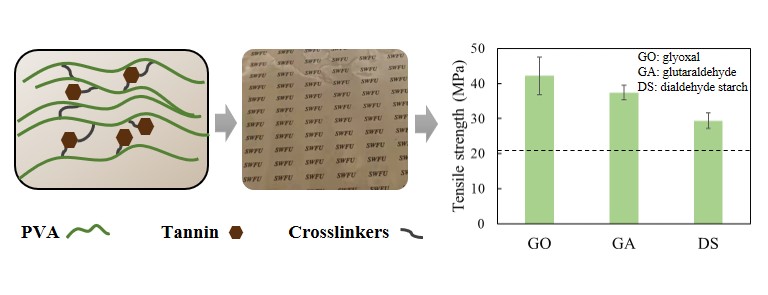 Open Access
Open Access
ARTICLE
Assisted Compatibility, and Balanced Regulation of the Mechanical, Thermal, and Antioxidant Activity of Polyvinyl Alcohol-Chinese Bayberry Tannin Extract Films Using Different Di-Aldehydes as Cross-Linkers
1
Beijing Forestry University, Beijing, 100083, China
2
Yunnan Provincial Key Laboratory of Wood Adhesives and Glued Products, Southwest Forestry University, Kunming, 650224, China
3
Zhejiang Academy of Forestry, Hangzhou, 310023, China
4
Department of Polymers and Pigments, National Research Centre, Cairo, 12622, Egypt
* Corresponding Authors:Xiaojian Zhou. Email: ; Guanben Du. Email:
(This article belongs to the Special Issue: Food Packaging Materials Based on Renewable Resources)
Journal of Renewable Materials 2022, 10(2), 359-372. https://doi.org/10.32604/jrm.2021.016335
Received 26 February 2021; Accepted 07 April 2021; Issue published 30 August 2021
Abstract
Polyvinyl alcohol (PVA)-based films containing Chinese bayberry tannin (BT) were prepared by cross-linking using glyoxal, glutaraldehyde and dialdehyde starch, individually. The presence of cross-linkers was evident to promote the transparency and decrease the moisture content of PVA/BT films, while the water solubility stayed almost unchanged in the cross-linked PVA/BT films. All cross-linkers provided promotion of the water vapor permeability, mechanical property and thermal stability of PVA/BT films. The best water vapor barrier capacity was found in case of glutaraldehyde cross-linked PVA/BT film, while the highest tensile strength was encountered in case of glyoxal cross-linked PVA/BT films, compared with the uncross-linked films. The scavenging action of the films towards DPPH radical activity was influenced by the nature of each cross-linker. Namely, the PVA/AT film cross-linked by glutaraldehyde acquired the lowest radical scavenging activity in a certain time, suggesting that glutaraldehyde decreased the release rate of BT from PVA. Based on the experimental data, glutaraldehyde and dialdehyde starch could be more suitable for PVA/BT film preparation since they can promote the intermolecular interaction of PVA and BT to a reasonable extent.Graphic Abstract

Keywords
Cite This Article
 Copyright © 2022 The Author(s). Published by Tech Science Press.
Copyright © 2022 The Author(s). Published by Tech Science Press.This work is licensed under a Creative Commons Attribution 4.0 International License , which permits unrestricted use, distribution, and reproduction in any medium, provided the original work is properly cited.


 Submit a Paper
Submit a Paper Propose a Special lssue
Propose a Special lssue View Full Text
View Full Text Download PDF
Download PDF Downloads
Downloads
 Citation Tools
Citation Tools